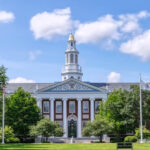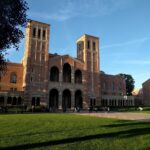College Students Find Religion
A growing number of students are responding to the increasingly secular, even pagan, nature of most colleges and universities by a taking a walk, to a more religious institution of higher learning.
Today, there are around 700 religious schools with about 1.3 million students, according to Naomi Schaefer Riley [pictured] of the Ethics and Public Policy Center. These students “reject the spiritually empty [nature] of secular schools,” says Riley, author of God on the Quad: How Religious Colleges and the Missionary Generation Are Changing America.
As more students choose to attend religious schools, the schools themselves are becoming increasingly visible, Riley said last month at the Heritage Foundation. The schools range from fundamentalist Christian, like Bob Jones University in South Carolina, to Soka University of America, a Buddhist school in California.
Students at religious colleges and universities reject the relativism of secular colleges. Riley cited a study done by the National Association of Scholars which found that 25% of students believe that there are universal values. Yet, despite the trend toward relativism on secular campuses, students are embracing the study of ethics. Riley noted the emergence of a “new sport” on campuses—the “ethics bowl” in which students debate often absurd scenarios. The “ethics bowl” formats, however, are hardly formative, according to Riley. “There is little evidence that students are equipped to determine what is right and wrong,” she said.
Religious schools are academically rigorous and strict, yet students have embraced these characteristics. Indeed, these students welcomed the return of what has disappeared at secular institutions, such as same-sex dormitories. The climate of these schools appeals to students who study hard and are socially conservative. They have “challenged the model of college behavior,” according to Riley.
A common perception of religious schools is that they shield their students from the world and are doctrinaire. Yet, according to Riley, academic freedom thrives at these schools. At religious schools, academic freedom is considered a “freedom of community, rather than of individuals.” And, religious schools, like their secular counterparts, are concerned with diversity, though many boast a large international student population.
Religious schools help explode the myth that “religious folks are intellectually backward,” according to Riley. Students at these schools “try to find what God is calling them to,” and, as a result, are bringing a sense of vocation and purpose with them to campus.
The Missionary Generation is significant off of college campuses because it signals the “vanguard of a more conservative generation,” says Riley. However, the conservatism of this generation is unlike the conservatism of their parents’ generation. While today’s students embrace the notion of universal values, they view the world with compassion, according to Riley. Religious college students oppose abortion in greater numbers than religious members of their parents’ generation, yet they are more tolerant of homosexual marriage. Today’s students are tolerant of homosexuality, though they view homosexual acts as off-limits. They also “see a mission to heal racial wounds” and are wary of bringing their beliefs into the public sphere.
The Missionary Generation is “more nuanced than the Religious Right of the 1980s.” While religious colleges are sending more and more students into the culture, this is “not the Fourth Great Awakening,” according to Riley.
Larry Scholer is a staff writer at Accuracy in Academia.




